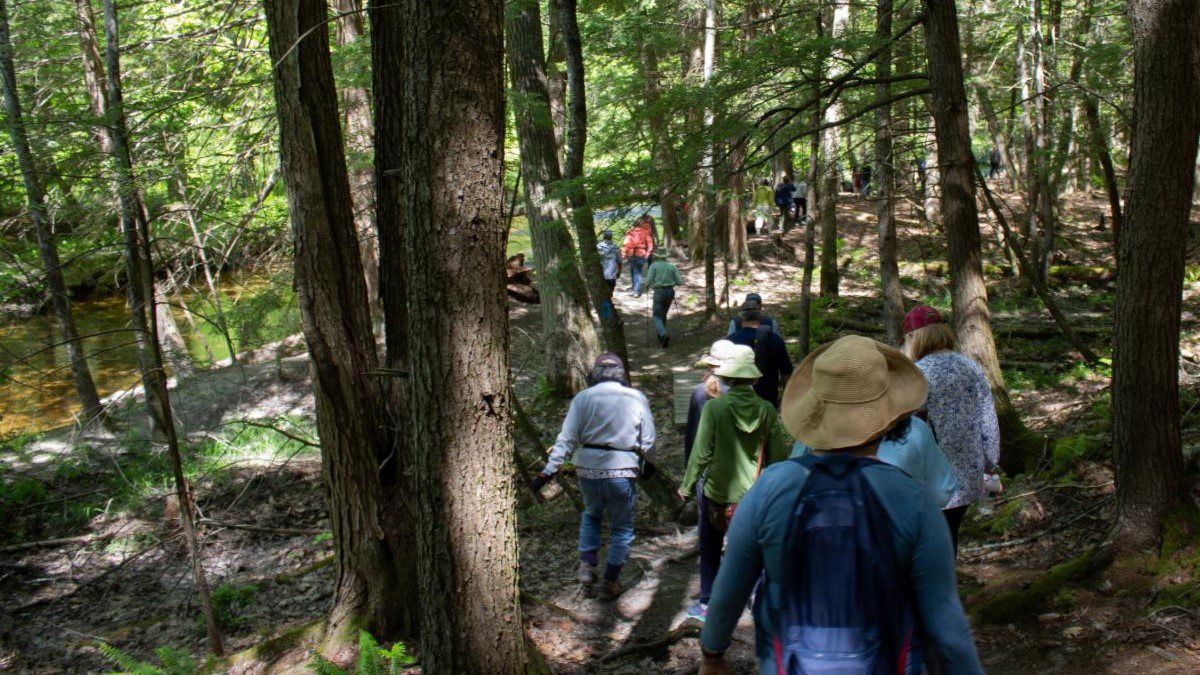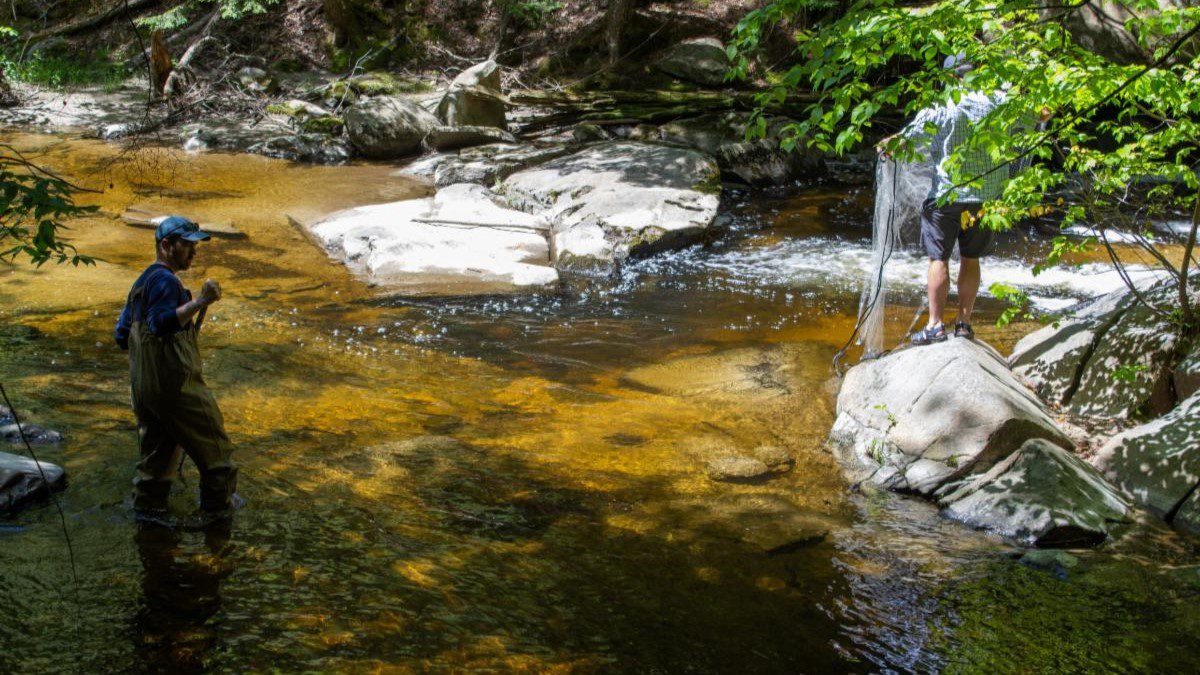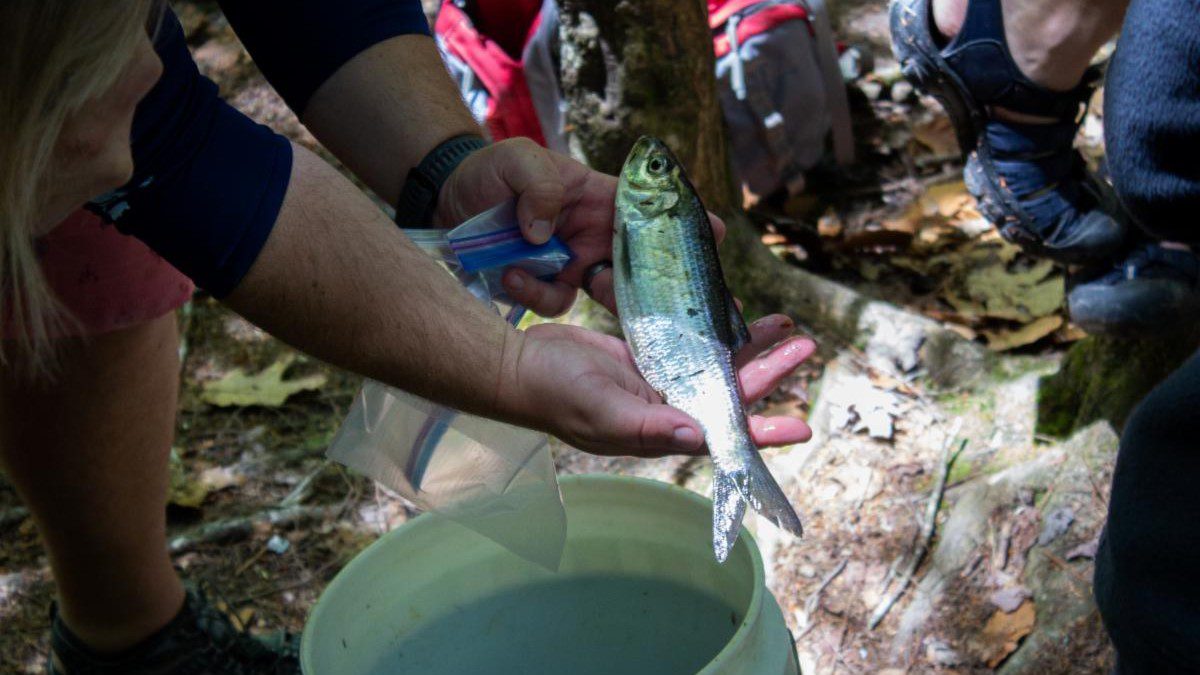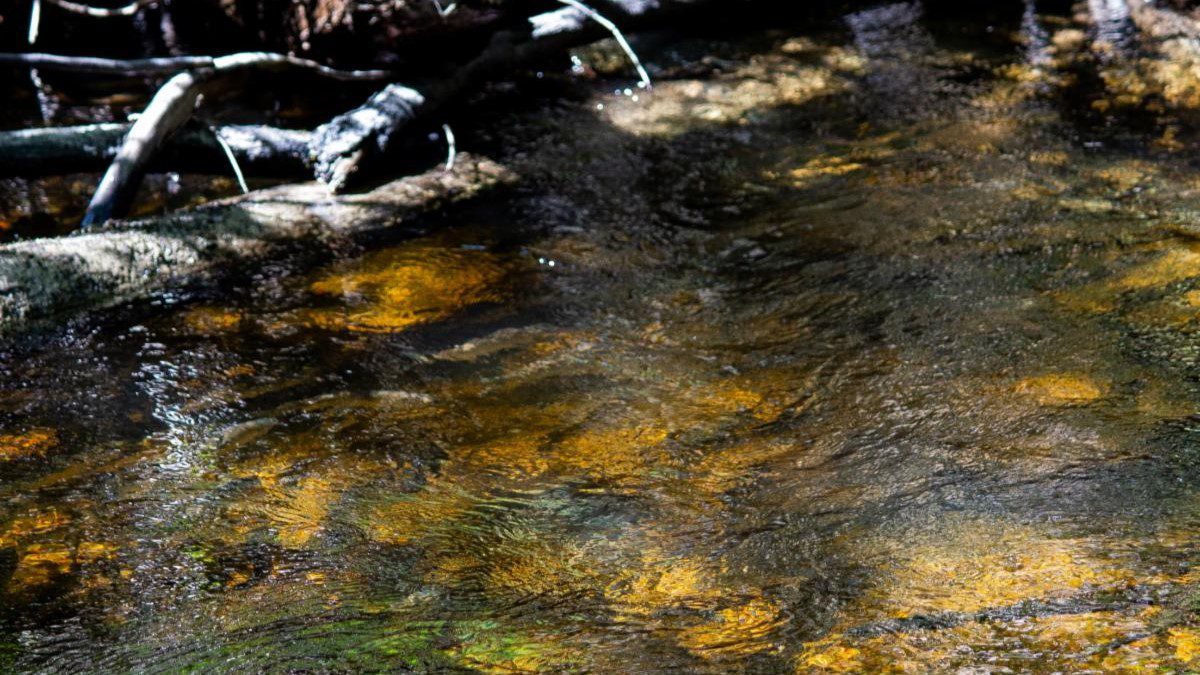In the woods of Westbrook, Brenna Crothers had a tiny natural crisis on her hands. She paced along the shady bank of Mill Brook as, beneath shimmering bottle-brown water, a group of a dozen or so dark shapes darted back and forth in front of an accidental dam.
The problem was a “snag” of logs, brush and debris, left by a recent storm in the path of a small spring miracle — an annual upstream run of alewives.
“Oh my gosh, I want to help them,” said Crothers. She works with Presumpscot Regional Land Trust and led alewife tours for several dozen people with staff from the Gulf of Maine Research Institute this week.
Alewives are a species of river herring — “small, silvery, oily,” and “anadromous” like salmon, said GMRI researcher Zach Whitener. “It means you live in the ocean, spawn in fresh water.” This makes alewives a key seasonal smorgasbord for birds and all manner of other inland critters.
“As they come into these little tiny brooks, what’s really cool is they’re bringing ocean nutrients — so these calories that they acquired from the ocean, they’re bringing them into upland ecosystems,” Whitener said. “It’s basically bringing the bounty of the sea into places like Mill Brook, Highland Lake, that otherwise would be very nutrient-limited.”
The Presumpscot River and Mill Brook, a tributary, see a relatively small annual run of 50,000 to 100,000 alewives, winding their way from the Atlantic Ocean up to Highland Lake in Windham. The fish traverse complex chutes, ladders and elevators across human-made dams and navigate falls where they need water levels to be just right (alewives are poor jumpers).
Now the tour group watched from shore as this one group of fish crowded up against the snag in the brook, probing for a way through. Crothers had been worried about this very spot. She pulled out her phone.
“I’m going to call our stewardship person,” she said. “He’s coming tomorrow.”
The land trust’s staff sometimes removes larger snags like this one to help these “sea-run” fish get to where they need to go: still waters upstream where they’ve returned for many generations. They wouldn’t be able to spawn successfully anywhere else, Crothers said — “they’re just stubborn.”
Maine’s spring alewife runs are a delicate dance around changing water conditions and obstacles both natural and human-made. This ephemeral phenomenon happens in dozens of places up and down the Maine coast, and the Presumpscot is a microcosm of how these runs have been reshaped by people — through development, overfishing, infrastructure and climate change.

Slow restoration
The Presumpscot, from the Abenaki word for “many falls,” was once a hotbed of migrating fish used by indigenous people as food and fertilizer. European colonization drastically transformed this ecosystem. According to the Friends of the Presumpscot River, it was the site of Maine’s first paper mill, first dam and first hydroelectric installation.
Alewives were overfished and blockaded out of existence on the Presumpscot for 200 years, said Whitener. Then in the late 1990s, a storm blew out part of a key dam that kept the fish from their spawning grounds.
State officials decided it was time to clear the way. They trucked in mildly confused alewives from the Androscoggin River to breed in Highland Lake, where the new generations would imprint on a new spawning ground.
By the time the dam was removed in 2002, Whitener said, “there were already adult fish bumping at the bottom ready to go.”
There are many such alewife success stories in Maine. The Penobscot River now sees what may be the state’s largest alewife run, Whitener said. It had dwindled to around a thousand fish before a pair of dam removals and the installation of a fish bypass on a third in the past decade or so. This year, the run is at 3 million and counting.
Federal fishery managers rated alewives at low risk of extinction in a 2019 study and declined to list them as an endangered species. But the recovery has a long way to go. State officials told News Center Maine last week that current runs are about 5% the size of what they were even a century ago.
Many are still stymied by dams. Every year on the Mousam River in Southern Maine, schools of fish swim from the sea into downtown Kennebunk, where they come to a halt at the base of the Kesslen Dam. This is one of many alewife runs that cannot reach its spawning grounds, said Maine Rivers executive director Landis Hudson by phone this week.
Kennebunk has explored removing this and other hydro dams on the lower Mousam, but it’s an extremely slow and complex regulatory process.
“There are so many profoundly frustrating situations,” Hudson said, that “balance the joy and inspiration” of successful alewife restorations — like one her group worked on last year on China Lake, where three dams were removed and three more fitted with complex fish passages, clearing the way for nearly a million alewives to return up the Sebasticook River.
One lesson from this project, Hudson said, was that the fish passages were about six times as expensive as outright dam removal. “Fishways are not as valuable, not as healthy as a free-flowing river,” she said.

Changing conditions
Alewives also face natural challenges on their annual journey, but even these bear human fingerprints.
“We’ve had a lot of really intense storms with much higher-than-average rainfall and flooding,” said GMRI’s Brenda Downs during the hike in Westbrook. “As the climate changes here and the weather patterns change, that’s something we’re seeing, and (we’re) monitoring the ecosystem to make sure that things can move through the way that they always have.”
Heavier, more sporadic rains are a hallmark of climate change in the Northeast and beyond. High winds in these rainstorms bring down trees. This debris is washed into waterways by rain and increasing runoff, driven by development. It may create more of the snags that vex sea-run fish.
“If they get stuck behind one or two too many of those, it could be a really bad year for the spawning, which then impacts the stocks for years to come,” Downs said.
More gradual, gentle, regular rains are the ticket to clearing these snags naturally — but that’s not the kind that warming temperatures are driving. These changing rainfall patterns may also affect the timing of alewives, said Whitener. Many runs started early in Maine this year, but the Presumpscot’s was late, because heavy rain swelled one waterfall too high for the fish to pass.
“These fish that we’ve been seeing today are really stressed,” he said. “Then when they come up here, now they’ve made it over the falls, they need it to rain to blow some of this (debris) out and give them more water to travel.”
And the cycle continues — when a new generation of juvenile fish is ready to leave the lake upstream in the late summer and early fall, they’ll need high enough water to get over a dam and back on their way to the sea.
“The theory is that … if there’s not enough water going over the spillway of the dam, the juveniles get stuck in the lake,” Whitener said. “So they’ll end up spending longer in the lake, up to overwintering,” when they can run out of food, be vulnerable to predators, and see stunted growth.
“If they had a more natural outflow, if they didn’t have dams to worry about, there would be more opportunity for them to go downstream whenever they want to,” he said.

‘Fishing for science’
Upstream from the snag in Mill Brook, the Westbrook tour group stopped at a gently sloping falls topped with a rocky pool. Thousands of fish can get stuck here for up to a week at a time waiting for the right water levels. It’s allowed GMRI to study the changing run in this spot for about a decade.
And then, miraculously, there were fish.
A few small groups of alewives glinted in the rapids. They had found a way to squeeze through the logjam downstream, stubbornly swimming onward.
Behind a rope to keep seasonal alewife-peepers from disturbing the run, the happy hikers gathered on the banks. “I just like the rejuvenation of life — the perpetual occurrence of another generation,” said Denise Larue of South Portland.
Science and monitoring are key to understanding and preserving that cycle in a changing ecosystem. Whitener managed to catch one alewife in a net to sample back at GMRI’s lab, while two colleagues took water samples to analyze for “environmental DNA.”
This is a relatively new tool that the University of Maine is working to adapt for coastal ecosystems — it can estimate how many fish have been in sampled water by measuring genetic signatures from scales and waste, with less disruption and harm to delicate species.
“Scientists can’t be next to the water, in the water, making these observations all the time,” said Downs. “So the fish don’t actually have to be here, physically, for us to be able to see them.”
In fact, zero is as interesting as any number when “fishing for science,” said Whitener.
“Oftentimes, if you’re using fishery-dependent data, the only data you’ll get back is when they caught fish,” he said. “It’s really important to have data that contains zeroes, to know the conditions when fish weren’t present.”
But by the time you’re reading this, the Presumpscot alewife run should be in full force. Thousands of fish will darken Mill Brook, doing their best to follow some encoded memory from sea to lake to carry on their species.
“They’re wild creatures that come into places that we know,” said Hudson. “There’s something magical about creatures that use senses that we don’t completely understand (in a way) that intersects and overlaps with our world.”
To read the full edition of this newsletter, see Climate Monitor: Running with the alewives. Reach Annie Ropeik with story ideas at: moc.l1767599560iamg@1767599560kiepo1767599560ra1767599560.







